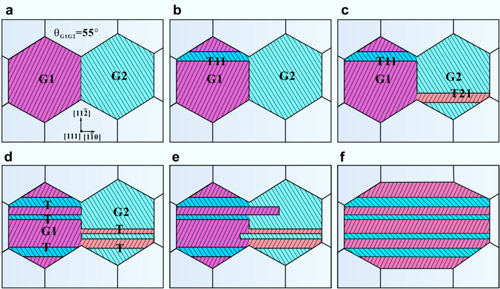Recently, the research team led by Prof. ZHANG Guang-Ping from Shenyang National Laboratory for Materials Science, Institute of Metal Research, Chinese Academy of Sciences online published the new findings in grain growth mechanism of metal films subjected to cyclic loading in Nature Communications [5:3021(2014), doi: 10.1038/ncomms4021].
Although a grain boundary (GB), as an effective barrier to dislocation motion, plays a key role in enhancing yield strength of polycrystalline metals through reducing grain size down to nanometre scales, GBs in nano-grained metals usually become so unstable that grain growth characterized by GB migration/grain coarsening always occurs under various loading modes including tension, compression, nanoindentation and cyclic deformation. In addition, upon plastic deformation of an nc fcc-structured metal, Shockley partial dislocations are usually emitted from GBs, leading to frequent twin nucleation. These twin-related GB activities may give rise to questions whether the nano-GB migration is related to nanotwins. If so, the question arises how these GBs migrate through formation of nanotwins and how the nanograins become coarsened.
To answer these basic questions, Prof. Zhang and his team conducted the research on 20-nm-thick gold films with a grain size of 19 nm under cyclic loading. Based on the atomic-scale observations and analyses, they revealed that the formation of nanotwins is an effective way to assist grain coarsening following a fundamental process that the mutual formation of nanotwins in two neighbouring grains changes the local grain orientation and dissociates the GBs into new segments, which become more mobile. This work may have important implications for understanding the interface-mediated mechanisms of cyclic plastic deformation and for the interface engineering design of nanostructured metals with both high strength and good fatigue resistance.
This work was supported by the National Natural Science Foundation of China, the National Basic Research Program of China and Chinese Academy of Sciences.

Fig. 1 GB dissociation induced by twin formation. (a,d) TEM images of two typical examples for large grains with parallel multi-twins in the fatigued samples. (b,c) and (e,f) The corresponding details of the microstructures, respectively. Scale bars: (a, d-f) 5 nm, (b, c) 1 nm. (image by IMR)

Fig.2 Schematic illustration of nanotwin-assisted grain growth mechanism.(image by IMR)